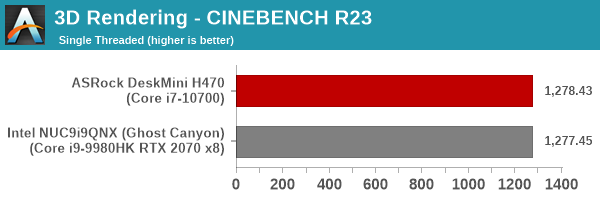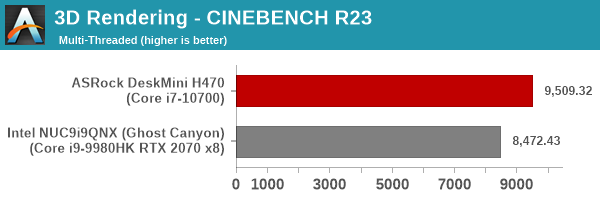ASRock DeskMini H470 Review: A No-Frills LGA 1200 mini-PC Platform
by Ganesh T S on December 29, 2020 8:00 AM ESTMiscellaneous Performance Metrics
This section looks at some of the other commonly used benchmarks representative of the performance of specific real-world applications.
3D Rendering - CINEBENCH
We use CINEBENCH R15 and R23 for 3D rendering evaluation. R15 provides three benchmark modes - OpenGL, single threaded and multi-threaded, while R23 provides only single and multi-threaded modes. Evaluation of different PC configurations in all supported modes provided us the following results.





CINEBENCH R23 seems to be better optimized for the newer Intel processors - In R15, the multi-threaded workload performance put the Core i9-9980HK in a better position than the Core i7-10700. In R23, we see the situation reversed (as it should be, given that the Core i7-10700 has a 20W additional TDP budget to work with). In the R15 OpenGL performance, we see the iGPU-only machines perform worse than the dGPU-equipped ones. In the iGPU category, it is no surprise that the AMD one performs better.
x265 Benchmark
Next up, we have some video encoding benchmarks using x265 v2.8. The appropriate encoder executable is chosen based on the supported CPU features. In the first case, we encode 600 1080p YUV 4:2:0 frames into a 1080p30 HEVC Main-profile compatible video stream at 1 Mbps and record the average number of frames encoded per second.

Our second test case is 1200 4K YUV 4:2:0 frames getting encoded into a 4Kp60 HEVC Main10-profile video stream at 35 Mbps. The encoding FPS is recorded.

The 8C/16T configuration of the Ghost Canyon NUC and the DeskMini H470 helps them get the top two slots, while the other systems are at a core count and clock-speed disadvantage.
7-Zip
7-Zip is a very effective and efficient compression program, often beating out OpenCL accelerated commercial programs in benchmarks even while using just the CPU power. 7-Zip has a benchmarking program that provides tons of details regarding the underlying CPU's efficiency. In this subsection, we are interested in the compression and decompression rates when utilizing all the available threads for the LZMA algorithm.


This is again a benchmark / utility program that loves multiple cores, and the fast 8C/16T configuration again sees the Ghost Canyon NUC and the DeskMini H470 in the top two. Since the benchmark is not a sustained one, the 5GHz turbo helps the Ghost Canyon NUC edge ahead in both components.
Cryptography Benchmarks
Cryptography has become an indispensable part of our interaction with computing systems. Almost all modern systems have some sort of hardware-acceleration for making cryptographic operations faster and more power efficient. In this sub-section, we look at two different real-world applications that may make use of this acceleration.
BitLocker is a Windows features that encrypts entire disk volumes. While drives that offer encryption capabilities are dealt with using that feature, most legacy systems and external drives have to use the host system implementation. Windows has no direct benchmark for BitLocker. However, we cooked up a BitLocker operation sequence to determine the adeptness of the system at handling BitLocker operations. We start off with a 2.5GB RAM drive in which a 2GB VHD (virtual hard disk) is created. This VHD is then mounted, and BitLocker is enabled on the volume. Once the BitLocker encryption process gets done, BitLocker is disabled. This triggers a decryption process. The times taken to complete the encryption and decryption are recorded. This process is repeated 25 times, and the average of the last 20 iterations is graphed below.


The benchmark numbers are affected by multiple aspects - the speeds of the AES-NI engines, core counts, memory speed, and memory latency. The DeskMini H470 comes in the middle of the pack.
Creation of secure archives is best done through the use of AES-256 as the encryption method while password protecting ZIP files. We re-use the benchmark mode of 7-Zip to determine the AES256-CBC encryption and decryption rates using pure software as well as AES-NI. Note that the 7-Zip benchmark uses a 48KB buffer for this purpose.


The 65W TDP budget and the 8C/16T configuration help the Core i7-10700-equipped DeskMini H470 emerge the winner when access to the external DRAM is not a factor (the 48KB buffer easily fits within the processor memory)
Yet another cryptography application is secure network communication. OpenSSL can take advantage of the acceleration provided by the host system to make operations faster. It also has a benchmark mode that can use varying buffer sizes. We recorded the processing rate for a 8KB buffer using the hardware-accelerated AES256-CBC-HAC-SHA1 feature.


AMD's hardware acceleration for OpenSSL enables it to decrypt much faster than the competition and perform admirably for encryption. The Ghost Canyon NUC and DeskMini H470 perform similar to each other, but the DeskMini A300 with the Ryzen 5 2400G walks away with the overall honors.
Agisoft Photoscan
Agisoft PhotoScan is a commercial program that converts 2D images into 3D point maps, meshes and textures. The program designers sent us a command line version in order to evaluate the efficiency of various systems that go under our review scanner. The command line version has two benchmark modes, one using the CPU and the other using both the CPU and GPU (via OpenCL). We present the results from our evaluation using the CPU mode only. The benchmark (v1.3) takes 84 photographs and does four stages of computation:
- Stage 1: Align Photographs (capable of OpenCL acceleration)
- Stage 2: Build Point Cloud (capable of OpenCL acceleration)
- Stage 3: Build Mesh
- Stage 4: Build Textures
We record the time taken for each stage. Since various elements of the software are single threaded, and others multithreaded, it is interesting to record the effects of CPU generations, speeds, number of cores, and DRAM parameters using this software.




This benchmark is one that loves fast high-performance cores capable of sustaining high clock rates. It is no surprise that the 65W 8C/16T configuration helps the DeskMini H470 be in the top three across all stages.
Dolphin Emulator
Wrapping up our application benchmark numbers is the new Dolphin Emulator (v5) benchmark mode results. This is again a test of the CPU capabilities.

The DeskMini H470 performs almost as good as the Ghost Canyon NUC and is at the top of the charts.










26 Comments
View All Comments
Tomatotech - Tuesday, December 29, 2020 - link
That’s possibly one of the best possible arrangements for the m.2 slot then as the metal tray will be an excellent heat sink. You could even add a bit of thermally conductive foam (make sure it’s not the electrically conductive type) to help with heat transfer to the tray.ganeshts - Tuesday, December 29, 2020 - link
The Ultra M.2 slot is on the top side of the board. That is the one used with Comet Lake CPUs. The slot you are referring to is the Hyper M.2 (PCIe 4.0 x4) slot which is usable only when the Rocket Lake CPUs come around.twotwotwo - Tuesday, December 29, 2020 - link
Its AMD relative the A300 was my main machine for a while, and had it been easier to get Zen 2 desktop APUs I might still be using it. Quiet (given a decent fan), cheap, tiny (obvs), reasonably expandable, gets the job done--about all I can ask for from a work desktop.Death666Angel - Tuesday, December 29, 2020 - link
The 4000 Series Pro APUs are pretty well available in Germany, from reputable online retailers. I can get the R5 Pro 4650G for 20% more than the equivalent R5 3600 (200€ vs 240€ roughly). That would be my sweet spot, personally. For 8 cores it's also roughly 20% (280€ vs 340€) but for that price difference, you could get a nice used GPU already that will maybe game better. I personally could never justify a GPU-less build, although I am eternally curious about them and plot one out once every couple of months.... and then I look at benchmarks of dGPU vs iGPU and stop. :DTomatotech - Tuesday, December 29, 2020 - link
I didn’t see it in the article so here are the specs:155 x 155 x 80 mm (1.92L)
Not bad, though for most low to mid-level use cases it’d be far cheaper to buy a used Lenovo or Dell USFF PC - these have even less volume at around 1.1L but are slightly larger and flatter (around 180x180x35mm)
For SFF with GPU I still prefer something like the K39 mITX chassis on the low end which comes in at 3L but allows you to use most full-sized GPUs (but for now possibly not the nVidia 3000 series).
Samus - Tuesday, December 29, 2020 - link
I've been rocking the FT03-Mini and while it is an absolute nightmare to work inside of (and I question my sanity for why I put myself through owning it) it is still a very effective ITX chassis for the size, capable of 10.5" videocards, multiple hard drives (plus two m2 drives you can mount to most current motherboards) while using a single 140mm fan to cool everything. Realistically the highest TDP CPU you want to use is around 88-watts as anything more you will stress any closed loop cooler with a 25mm radiator (the max the case can accept) and need to go to a heatsink of some sort with another dedicated fan.Obrut - Tuesday, December 29, 2020 - link
It will be interesting to see a comparison with ASRock Jupiter H470, which has a much different form factor and cooling solution.M O B - Tuesday, December 29, 2020 - link
I have a Deskmini 310w--is the UHD 630 on 10th gen CPUs any faster than the UHD 630 on older CPUs?If not, then it seems like this iteration basically adds some USB 3.0 ports versus my current build.
ganeshts - Wednesday, December 30, 2020 - link
I think the additional angle here is that of a low-cost platform that can take advantage of the RKL-S CPUs coming in 2021. Personally, I also think it is not a great choice to upgrade for those who already have the 310. It is meant more for folks getting their first mSTX machine.Samus - Tuesday, December 29, 2020 - link
I had the SST-AR11 cooler in my Silverstone FT03-Mini and was pretty disappointed (partially due to the chassis inherently poor ventilation) and equally disappointed by closed-loop coolers due to the 25mm thickness limitation of radiators. After spending seemingly hundreds of dollars and way too much time hunting for a thermal solution, some forum posts directed me to try the NT06-Pro, which would theoretically fit this mSTX chassis as long as there is no interference with the power supply.It performs incredible well as you position the fan under the fins and blow the heat away from the motherboard instead of onto it, giving it somewhat of the beneficial effect of a tower-style cooler.